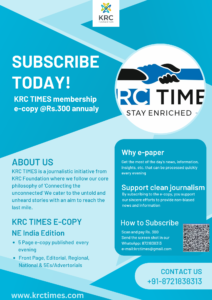This critical analysis evaluates the progress of India and Pakistan since their independence, examining the factors behind India’s relative prosperity and Pakistan’s challenges across various dimensions
 KRC TIMES Desk
KRC TIMES Desk

B S Dara
Following the partition of British India in August 1947, two independent nations, India and Pakistan, emerged. Despite their shared historical, cultural, and geographical origins, the paths of these countries have significantly diverged over the past 77 years.
This critical analysis evaluates the progress of India and Pakistan since their independence, examining the factors behind India’s relative prosperity and Pakistan’s challenges across various dimensions.
Since gaining independence together in 1947, India and Pakistan have followed distinct paths influenced by their individual circumstances. India’s strong democratic institutions, strategic economic reforms, and focus on technological and educational advancements have positioned it as a rising global force.
Despite facing numerous obstacles like poverty, inequality, and regional conflicts, India’s diverse economy, emphasis on innovation, and democratic resilience have played pivotal roles in its overall advancement and international reputation.
Pakistan, on the other hand, has struggled with political instability, recurring military interventions, and a narrower economic base. While the country has made some progress in areas such as defence capabilities and strategic alliances, particularly with China, these achievements have often come at the expense of social and economic development.
Pakistan’s heavy military expenditure, coupled with inconsistent economic policies and reliance on foreign aid, has hindered sustainable growth.
Comparative Analysis of Key Factors : Political Stability and Governance: India’s relatively stable democratic institutions have provided a framework for consistent policy implementation and long-term planning. In contrast, Pakistan’s history of military coups and political turmoil has led to policy discontinuity and governance challenges.
The dominance of the military in Pakistan’s political landscape has often sidelined civilian governance, impacting socio-economic development. Pakistan has experienced several military coups in its history with its impact been significant and far-reaching.

General Ayub Khan overthrew the civilian government in 1958, General Zia-ul-Haq carried out a coup and executed Prime Minister ZA Bhutto in 1977,General Pervez Musharraf led a coup in 1999 seizing the power and ruled the country till 2008.
Economic Policies and Growth: India’s economic liberalization in the 1990s unleashed a wave of growth, particularly in the IT and services sectors. The country has successfully attracted foreign direct investment and integrated into the global economy. Pakistan’s economy has been plagued by its heavy reliance on external debt, and a lack of industrial diversification.
Frequent IMF bailouts highlight persistent economic vulnerabilities. Pakistan’s economic challenges can be understood from the fact that recently, the country has been worried about the potential scenario of an economic default, but the situation has been temporarily eased by the latest agreement between Pakistan and the IMF.
Social Development and Human Capital: India’s investments in education and healthcare have yielded improvements in literacy rates, life expectancy, and gender equality. Pakistan’s social indicators lag behind, with significant issues in education, healthcare, and gender equality. Political instability and insufficient public sector investment have exacerbated these challenges.
Foreign Policy and International Relations: India’s foreign policy has been marked by strategic partnerships with major powers, including the United States, Russia, and the European Union. It has also played a crucial role in regional organizations like SAARC and BRICS and has gained prominence in international forums like the G20. Pakistan’s foreign policy has been heavily influenced by security concerns and its alliance with the United States and China.
Defence and Security : Both countries have invested heavily in defence, but with different implications. India’s focus on modernization and strategic partnerships has bolstered its defence capabilities while supporting economic growth. Pakistan’s heavy military expenditure has often come at the cost of social and economic development.
The country’s security concerns, particularly with India, have dominated its defence policy. Pakistan-backed insurgents have actively turned against thestate, leading to internal security challenges.
Technological and Scientific Advancements : India’s robust tech industry and significant achievements in space exploration and pharmaceuticals highlight its advancements in technology and science. Government initiatives have further spurred innovation.
India’s ISRO has emerged a world leader in space technology with its cost-effective satellite launches for clients like the United States. In 2013, India became the first Asian country to reach Mars and the fourth space agency globally to do so. In 2008 and 2019, India set its feet on Moon.
Unlike India, Pakistan has not developed any space program comparable to ISRO and the country has remained battling its social-economic issues.
Cultural Influence and Soft Power : India’s rich cultural heritage and global diaspora have given it significant soft power. Bollywood, yoga, and Indian cuisine have global appeal, enhancing India’s cultural influence.
Pakistan’s cultural influence, though rich and diverse, has been more limited. Security concerns and political instability have affected its soft power, although Pakistani music and dramas have regional popularity.
Fault Lines in Pakistan : Militancy and Extremism : Pakistan’s involvement with militancy dates back to the Afghan-Soviet war, where it supported Mujahideen fighters. This policy extended into Kashmir, where Pakistan-backed insurgents have still been active.
Dominant Military : The Pakistani military has been a dominant force in the country’s politics and economy. It has ruled directly for extended periods and exerted significant influence even during civilian rule. This dominance has often sidelined democratic institutions and civilian governance.
Over-Indulgence in Militancy and Military Dominance : Pakistan’s initial support for militant groups was rooted in its strategic calculations, aiming to counter Indian influence in the region and secure its interests in Afghanistan. However, this strategy backfired, leading to internal insurgencies and international isolation.
Impact on Society : The over-indulgence in militancy has had severe social repercussions. Radicalization, sectarian violence, and terrorism have disrupted social cohesion and development. The education system has also been affected, with madrassas sometimes promoting radical ideologies.
Economic Consequences : Militancy and military dominance have diverted resources away from essential sectors like education, healthcare, and infrastructure. The economic cost of fighting internal insurgencies and maintaining a large military apparatus has been substantial.
Diplomatic Isolation : Pakistan’s association with militant groups has strained its relations with many countries and has led to economic sanctions and reduced foreign investment. Its international image has been tarnished, affecting its ability to engage globally.
In conclusion, India’s prosperity can be attributed to its democratic governance, economic policies, and strategic international relations. Meanwhile, Pakistan’s challenges stem from economic instability, governance issues, and a complex relationship with militancy and military dominance.



